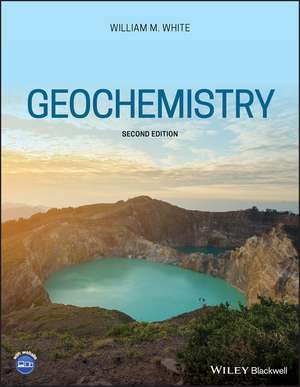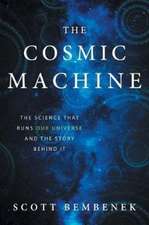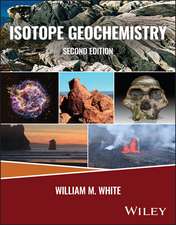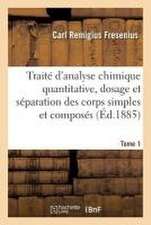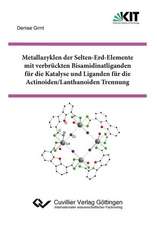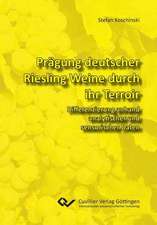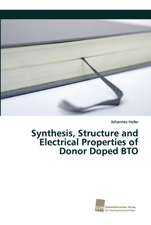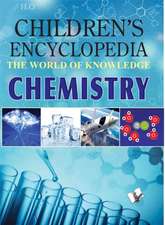Geochemistry, Second Edition
Autor WM Whiteen Limba Engleză Paperback – 7 oct 2020
Preț: 484.23 lei
Preț vechi: 605.28 lei
-20% Nou
Puncte Express: 726
Preț estimativ în valută:
92.66€ • 95.59$ • 77.32£
92.66€ • 95.59$ • 77.32£
Carte disponibilă
Livrare economică 05-19 martie
Livrare express 19-25 februarie pentru 97.09 lei
Preluare comenzi: 021 569.72.76
Specificații
ISBN-13: 9781119438052
ISBN-10: 1119438055
Pagini: 960
Dimensiuni: 217 x 277 x 40 mm
Greutate: 2.36 kg
Ediția:2nd Edition
Editura: Wiley
Locul publicării:Chichester, United Kingdom
ISBN-10: 1119438055
Pagini: 960
Dimensiuni: 217 x 277 x 40 mm
Greutate: 2.36 kg
Ediția:2nd Edition
Editura: Wiley
Locul publicării:Chichester, United Kingdom
Notă biografică
WILLIAM M. WHITE received his B.Sc. in Geology from the University of California, Berkeley, and a Ph.D. in Oceanography from the University of Rhode Island. He is a professor of earth and atmospheric sciences at Cornell University where he teaches geochemistry. He has been elected a fellow at the Geochemical Society/European Association of Geochemistry and the AGU and named as an ISI highly cited researcher.
Cuprins
Preface xv
About the companion website xvii
Chapter 1: Introduction 1
1.1 Introduction 1
1.2 Beginnings 1
1.3 Geochemistry in the twenty-first century 3
1.4 The philosophy of science 4
1.4.1 Building scientific understanding 4
1.4.2 The scientist as skeptic 5
1.5 Elements, atoms, crystals, and chemical bonds: some chemical fundamentals 6
1.5.1 The periodic table 6
1.5.2 Electrons and orbits 7
1.5.3 Some chemical properties of the elements 9
1.5.4 Chemical bonding 12
1.5.5 Molecules, crystals, and minerals 14
1.6 A brief look at the Earth 19
1.6.1 Structure of the Earth 19
1.6.2 Plate tectonics and the hydrologic cycle 20
1.7 A look ahead 22
References and suggestions for further reading 30
Chapter 2: Energy, entropy, and fundamental thermodynamic concepts 31
2.1 The thermodynamic perspective 31
2.2 Thermodynamic systems and equilibrium 32
2.2.1 Fundamental thermodynamic variables 34
2.2.2 Properties of state 34
2.3 Equations of state 35
2.3.1 Ideal gas law 35
2.3.2 Equations of state for real gases 36
2.3.3 Equation of state for other substances 37
2.4 Temperature, absolute zero, and the zeroth law of thermodynamics 37
2.5 Energy and the first law of thermodynamics 38
2.5.1 Energy 38
2.5.2 Work 39
2.5.3 Path independence, exact differentials, state functions, and the first law 40
2.6 The second law and entropy 41
2.6.1 Statement 41
2.6.2 Statistical mechanics: a microscopic perspective of entropy 42
2.6.3 Integrating factors and exact differentials 48
2.7 Enthalpy 50
2.8 Heat capacity 51
2.8.1 Constant volume heat capacity 52
2.8.2 Constant pressure heat capacity 52
2.8.3 Energy associated with volume and the relationship between Cv and Cp 52
2.8.4 Heat capacity of solids: a problem in quantum physics 53
2.8.5 Relationship of entropy to other state variables 58
2.8.6 Additive nature of silicate heat capacities 58
2.9 The third law and absolute entropy 59
2.9.1 Statement of the third law 59
2.9.2 Absolute entropy 59
2.10 Calculating enthalpy and entropy changes 60
2.10.1 Enthalpy changes due to changes in temperature and pressure 60
2.10.2 Changes in enthalpy due to reactions and change of state 61
2.10.3 Entropies of reaction 62
2.11 Free energy 65
2.11.1 Helmholtz free energy 65
2.11.2 Gibbs free energy 65
2.11.3 Criteria for equilibrium and spontaneity 65
2.11.4 Temperature and pressure dependence of the Gibbs free energy 66
2.12 The Maxwell relations 69
2.13 Summary 70
References and suggestions for further reading 71
Problems 71
Chapter 3: Solutions and thermodynamics of multicomponent systems 74
3.1 Introduction 74
3.2 Phase equilibria 75
3.2.1 Some definitions 75
3.2.2 The Gibbs phase rule 77
3.2.3 The Clapeyron equation 78
3.3 Solutions 80
3.3.1 Raoult's law 80
3.3.2 Henry's law 81
3.4 Chemical potential 81
3.4.1 Partial molar quantities 81
3.4.2 Definition of chemical potential and relationship to Gibbs free energy 82
3.4.3 Properties of the chemical potential 82
3.4.4 The Gibbs-Duhem relation 83
3.4.5 Derivation of the phase rule 84
3.5 Ideal solutions 84
3.5.1 Chemical potential in ideal solutions 84
3.5.2 Volume, enthalpy, entropy, and free energy changes in ideal solutions 84
3.6 Real solutions 86
3.6.1 Chemical potential in real solutions 86
3.6.2 Fugacities 87
3.6.3 Activities and activity coefficients 88
3.6.4 Excess functions 90
3.7 Electrolyte solutions 93
3.7.1 The nature of water and water-electrolyte interaction 93
3.7.2 Some definitions and conventions 94
3.7.3 Activities in electrolytes 96
3.8 Ideal solutions in crystalline solids and their activities 101
3.8.1 Mixing-on-site model 101
3.8.2 Local charge balance model 103
3.9 Equilibrium constants 104
3.9.1 Derivation and definition 104
3.9.2 Law of mass action 105
3.9.3 KD values, apparent equilibrium constants, and the solubility product 107
3.9.4 Henry's law and gas solubilities 108
3.9.5 Temperature dependence of equilibrium constant 108
3.9.6 Pressure dependence of equilibrium constant 109
3.10 Practical approach to electrolyte equilibrium 110
3.10.1 Choosing components and species 110
3.10.2 Mass balance 110
3.10.3 Electrical neutrality 111
3.10.4 Equilibrium constant expressions 112
3.11 Oxidation and reduction 113
3.11.1 Redox in aqueous solutions 114
3.11.2 Redox in magmatic systems 122
3.12 Summary 123
References and suggestions for further reading 124
Problems 125
Chapter 4: Applications of thermodynamics to the Earth 130
4.1 Introduction 130
4.2 Activities in nonideal solid solutions 130
4.2.1 Mathematical models of real solutions: Margules equations 130
4.3 Exsolution phenomena 135
4.4 Thermodynamics and phase diagrams 137
4.4.1 The thermodynamics of melting 138
4.4.2 Thermodynamics of phase diagrams for binary systems 140
4.4.3 Phase diagrams for multicomponent systems 143
4.5 Geothermometry and geobarometry 145
4.5.1 Theoretical considerations 145
4.5.2 Practical thermobarometers 146
4.6 Thermodynamic models of magmas 156
4.6.1 Structure of silicate melts 157
4.6.2 Magma solution models 158
4.7 Reprise: thermodynamics of electrolyte solutions 162
4.7.1 Equation of state for water 163
4.7.2 Activities and mean ionic and single ion quantities 163
4.7.3 Activities in high ionic strength solutions 168
4.7.4 Electrolyte solutions at elevated temperature and pressure 176
4.8 Summary 180
References and suggestions for further reading 181
Problems 184
Chapter 5: Kinetics: the pace of things 188
5.1 Introduction 188
5.2 Reaction kinetics 189
5.2.1 Elementary and overall reactions 189
5.2.2 Reaction mechanisms 189
5.2.3 Reaction rates 190
5.2.4 Rates of complex reactions 196
5.2.5 Steady state and equilibrium 199
5.3 Relationships between kinetics and thermodynamics 201
5.3.1 Principle of detailed balancing 201
5.3.2 Enthalpy and activation energy 201
5.3.3 Aspects of transition state theory 202
5.4 Diffusion 208
5.4.1 Diffusion flux and Fick's laws 208
5.4.2 Diffusion in multicomponent systems 212
5.4.3 Driving force and mechanism of diffusion 218
5.4.4 Diffusion in solids and the temperature dependence of the diffusion coefficient 219
5.4.5 Diffusion in liquids 221
5.4.6 Diffusion in porous media 223
5.5 Surfaces, interfaces, and interface processes 223
5.5.1 The surface free energy 225
5.5.2 The Kelvin effect 225
5.5.3 Nucleation and crystal growth 226
5.5.4 Adsorption 233
5.5.5 Catalysis 234
5.6 Kinetics of dissolution 237
5.6.1 Simple oxides 238
5.6.2 Silicates 240
5.6.3 Nonsilicates 244
5.7 Diagenesis 244
5.7.1 Compositional gradients in accumulating sediment 245
5.7.2 Reduction of sulfate in accumulating sediment 247
5.8 Summary 248
References and suggestions for further reading 250
Problems 252
Chapter 6: Aquatic chemistry 256
6.1 Introduction 256
6.2 Acid-base reactions 256
6.2.1 Proton accounting, charge balance, and conservation equations 257
6.2.2 The carbonate system 260
6.2.3 Conservative and nonconservative ions 264
6.2.4 Total alkalinity and carbonate alkalinity 264
6.2.5 Buffer intensity 268
6.3 Complexation 269
6.3.1 Stability constants 270
6.3.2 Water-related complexes 271
6.3.3 Other complexes 274
6.3.4 Complexation in fresh waters 275
6.4 Dissolution and precipitation reactions 278
6.4.1 Calcium carbonate in groundwaters and surface waters 278
6.4.2 Solubility of Mg 279
6.4.3 Solubility of SiO2 284
6.4.4 Solubility of Al(OH)3 and other hydroxides 285
6.4.5 Dissolution of silicates and related minerals 286
6.5 Clays and their properties 288
6.5.1 Clay mineralogy 289
6.5.2 Ion-exchange properties of clays 291
6.6 Mineral surfaces and their interaction with solutions 292
6.6.1 Adsorption 293
6.6.2 Development of surface charge and the electric double layer 297
6.7 Summary 305
References and suggestions for further reading 306
Problems 306
Chapter 7: Trace elements in igneous processes 309
7.1 Introduction 309
7.1.1 Why care about trace elements? 309
7.1.2 What is a trace element? 310
7.2 Behavior of the elements 311
7.2.1 Goldschmidt's classification 311
7.2.2 The geochemical periodic table 313
7.3 Distribution of trace elements between coexisting phases 324
7.3.1 The partition coefficient 324
7.3.2 Thermodynamic basis 324
7.4 Factors governing the value of partition coefficients 325
7.4.1 Temperature and pressure dependence of the partition coefficient 325
7.4.2 Ionic size and charge 325
7.4.3 Compositional dependency 331
7.4.4 Mineral-liquid partition coefficients for mafic and ultramafic systems 335
7.5 Crystal-field effects 338
7.5.1 Crystal-field theory 338
7.5.2 Crystal-field influences on transition metal partitioning 342
7.6 Trace element distribution during partial melting 343
7.6.1 Equilibrium or batch melting 343
7.6.2 Fractional melting 344
7.6.3 Zone refining 344
7.6.4 Multiphase solids 344
7.6.5 Continuous melting 345
7.6.6 Constraints on melting models 349
7.7 Trace element distribution during crystallization 356
7.7.1 Equilibrium crystallization 356
7.7.2 Fractional crystallization 356
7.7.3 In situ crystallization 357
7.7.4 Crystallization in open system magma chambers 358
7.7.5 Comparing partial melting and crystallization 360
7.8 Summary of trace element variations during melting and crystallization 361
References and suggestions for further reading 362
Problems 364
Chapter 8: Radiogenic isotope geochemistry 367
8.1 Introduction 367
8.2 Physics of the nucleus and the structure of nuclei 369
8.2.1 Nuclear structure and energetics 369
8.2.2 The decay of excited and unstable nuclei 373
8.3 Basics of radiogenic isotope geochemistry and geochronology 378
8.4 Decay systems and their applications 383
8.4.1 Rb-Sr 383
8.4.2 Sm-Nd 384
8.4.3 Lu-Hf 388
8.4.4 Re-Os 391
8.4.5 La-Ce 396
8.4.6 U-Th-Pb 397
8.4.7 U and Th decay series isotopes 403
8.4.8 Isotopes of He and other rare gases 410
8.5 "Extinct" and cosmogenic nuclides 417
8.5.1 "Extinct" radionuclides and their daughters 417
8.5.2 Cosmogenic nuclides 420
8.5.3 Cosmic-ray exposure ages of meteorites 424
8.6 Summary 424
References and suggestions for further reading 425
Problems 429
Chapter 9: Stable isotope geochemistry 432
9.1 Introduction 432
9.1.1 Scope of stable isotope geochemistry 433
9.1.2 Some definitions 434
9.2 Theoretical considerations 435
9.2.1 Equilibrium isotope fractionations 435
9.2.2 Kinetic isotope fractionations 443
9.2.3 Mass-dependent and mass-independent fractionations 445
9.2.4 Isotopic clumping 447
9.3 Isotope geothermometry 449
9.4 Isotopic fractionation in the hydrologic system 453
9.5 Isotopic fractionation in biological systems 455
9.5.1 Carbon isotope fractionation during photosynthesis 455
9.5.2 Nitrogen isotope fractionation in biological processes 458
9.5.3 Oxygen and hydrogen isotope fractionation by plants 459
9.5.4 Biological fractionation of sulfur isotopes 459
9.5.5 Isotopes and diet: you are what you eat 460
9.5.6 Isotopic "fossils" and the earliest life 463
9.6 Paleoclimatology 464
9.6.1 The marine Quaternary delta18O record and Milankovitch cycles 465
9.6.2 The record in glacial ice 468
9.6.3 Soils and paleosols 469
9.7 Hydrothermal systems and ore deposits 471
9.7.1 Water in hydrothermal systems 471
9.7.2 Water-rock ratios 472
9.7.3 Sulfur isotopes and ore deposits 473
9.8 Mass-independent sulfur isotope fractionation and the rise of atmospheric oxygen 476
9.9 Stable isotopes in the mantle and magmatic systems 478
9.9.1 Stable isotopic composition of the mantle 478
9.9.2 Stable isotopes in crystallizing magmas 484
9.9.3 Combined fractional crystallization and assimilation 485
9.10 Non-traditional stable isotopes 486
9.10.1 Boron isotopes 486
9.10.2 Li isotopes 490
9.10.3 Calcium isotopes 492
9.10.4 Silicon isotopes 494
9.10.5 Iron isotopes 498
9.10.6 Mercury isotopes 501
9.11 Summary 503
References and suggestions for further reading 504
Problems 510
Chapter 10: The big picture: cosmochemistry 512
10.1 Introduction 512
10.2 In the beginning . . . nucleosynthesis 513
10.2.1 Astronomical background 513
10.2.2 The polygenetic hypothesis of Burbidge, Burbidge, Fowler, and Hoyle 514
10.2.3 Cosmological nucleosynthesis 516
10.2.4 Nucleosynthesis in stellar interiors 517
10.2.5 Explosive nucleosynthesis 520
10.2.6 Nucleosynthesis in interstellar space 524
10.2.7 Summary 525
10.3 Meteorites: essential clues to the beginning 526
10.3.1 Chondrites: the most primitive objects 526
10.3.2 Differentiated meteorites 536
10.4 Time and the isotopic composition of the solar system 539
10.4.1 Meteorite ages 539
10.4.2 Cosmic ray exposure ages and meteorite parent-bodies 545
10.4.3 Asteroids as meteorite parent-bodies 546
10.4.4 Isotopic anomalies in meteorites 550
10.5 Astronomical and theoretical constraints on solar system formation 556
10.5.1 Evolution of young stellar objects 557
10.5.2 The condensation sequence 560
10.5.3 The solar system 565
10.5.4 Other solar systems 569
10.6 Building a habitable solar system 569
10.6.1 Summary of observations 569
10.6.2 Formation of the planets 570
10.6.3 Chemistry and history of the moon 574
10.6.4 The giant impact hypothesis and formation of the earth and the moon 577
10.6.5 Tungsten isotopes and the age of the Earth 577
10.7 Summary 579
References and suggestions for further reading 580
Problems 584
Chapter 11: Geochemistry of the solid Earth 586
11.1 Introduction 586
11.2 The Earth's mantle 586
11.2.1 Structure of the mantle and geophysical constraints on mantle composition 588
11.2.2 Cosmochemical constraints on mantle composition 589
11.2.3 Observational constraints on mantle composition 590
11.2.4 Mantle mineralogy and phase transitions 591
11.3 Estimating mantle and bulk Earth composition 596
11.3.1 Major element composition 596
11.3.2 Trace element composition 597
11.3.3 Composition of the bulk silicate earth 600
11.4 The Earth's core and its composition 602
11.4.1 Geophysical constraints 602
11.4.2 Cosmochemical constraints 603
11.4.3 Experimental constraints 605
11.5 Mantle geochemical reservoirs 608
11.5.1 Evidence from oceanic basalts 609
11.5.2 Evolution of the depleted MORB mantle 612
11.5.3 Evolution of mantle plume reservoirs 616
11.5.4 The subcontinental lithospheric mantle 623
11.6 The crust 626
11.6.1 The oceanic crust 626
11.6.2 The continental crust 631
11.6.3 Growth of the continental crust 641
11.6.4 Refining the continental crust 647
11.7 Subduction zone processes 648
11.7.1 Major element composition 648
11.7.2 Trace element composition 649
11.7.3 Isotopic composition and sediment subduction 650
11.7.4 Magma genesis in subduction zones 652
11.8 Summary 655
References and suggestions for further reading 656
Problems 662
Chapter 12: Organic geochemistry, the carbon cycle, and climate 664
12.1 Introduction 664
12.2 A brief biological background 665
12.3 Organic compounds and their nomenclature 666
12.3.1 Hydrocarbons 666
12.3.2 Functional groups 668
12.3.3 Short-hand notations of organic molecules 671
12.3.4 Biologically important organic compounds 671
12.4 The chemistry of life: important biochemical processes 678
12.4.1 Photosynthesis 678
12.4.2 Respiration 680
12.4.3 The stoichiometry of life 682
12.5 Organic matter in natural waters and soils 682
12.5.1 Organic matter in soils 682
12.5.2 Dissolved organic matter in aquatic and marine environments 684
12.5.3 Hydrocarbons in natural waters 690
12.6 Chemical properties of organic molecules 691
12.6.1 Acid-base properties 691
12.6.2 Complexation 691
12.6.3 Adsorption phenomena 697
12.7 Sedimentary organic matter 701
12.7.1 Preservation of organic matter 701
12.7.2 Diagenesis of marine sediments 704
12.7.3 Diagenesis of aquatic sediments 706
12.7.4 Summary of diagenetic changes 707
12.7.5 Biomarkers 707
12.7.6 Kerogen and bitumen 712
12.7.7 Isotope composition of sedimentary organic matter 715
12.8 Petroleum and coal formation 718
12.8.1 Petroleum 718
12.8.2 Compositional evolution of coal 722
12.9 The carbon cycle and climate 724
12.9.1 Greenhouse energy balance 724
12.9.2 The exogenous carbon cycle 725
12.9.3 The deep carbon cycle 728
12.9.4 Evolutionary changes affecting the carbon cycle 730
12.9.5 The carbon cycle and climate through time 731
12.9.6 Fossil fuels and anthropogenic climate change 734
12.10 Summary 737
References and suggestions for further reading 738
Problems 742
Chapter 13: The land surface: weathering, soils, and streams 745
13.1 Introduction 745
13.2 Redox in natural waters 746
13.2.1 Biogeochemical redox reactions 747
13.2.2 Eutrophication 748
13.2.3 Redox buffers and transition metal chemistry 749
13.3 Weathering, soils, and biogeochemical cycling 754
13.3.1 Soil profiles 755
13.3.2 Chemical cycling in soils 757
13.3.3 Biogeochemical cycling 758
13.4 Weathering rates 761
13.4.1 The in situ approach 762
13.4.2 The watershed approach 767
13.4.3 Factors controlling weathering rates 773
13.5 The composition of rivers 777
13.6 Continental saline waters 780
13.7 Summary 783
References and suggestions for further reading 784
Problems 785
Chapter 14: The ocean as a chemical system 788
14.1 Introduction 788
14.2 Some background oceanographic concepts 788
14.2.1 Salinity, chlorinity, temperature, and density 789
14.2.2 Circulation of the ocean and the structure of ocean water 789
14.3 Composition of seawater 794
14.3.1 Speciation in seawater 797
14.3.2 Conservative elements 798
14.3.3 Dissolved gases 798
14.3.4 Seawater pH and alkalinity 802
14.3.5 Carbonate dissolution and precipitation 803
14.3.6 Nutrient elements 807
14.3.7 Particle-reactive elements 811
14.3.8 One-dimensional advection-diffusion model 812
14.4 Sources and sinks of dissolved matter in seawater 816
14.4.1 Residence time 817
14.4.2 River and groundwater flux to the oceans 818
14.4.3 The hydrothermal flux 823
14.4.4 The atmospheric source 831
14.4.5 Sedimentary sinks and sources 834
14.5 Summary 842
References 843
Problems 846
Chapter 15: Applied geochemistry 849
15.1 Introduction 849
15.2 Mineral resources 849
15.2.1 Ore deposits: definitions and classification 850
15.2.2 Orthomagmatic ore deposits 851
15.2.3 Hydromagmatic ore deposits 854
15.2.4 Hydrothermal ore deposits 864
15.2.5 Sedimentary ore deposits 870
15.2.6 Weathering-related ore deposits 876
15.2.7 Rare earth ore deposits 878
15.2.8 Geochemical exploration: finding future resources 882
15.3 Environmental geochemistry 886
15.3.1 Eutrophication redux 887
15.3.2 Toxic metals in the environment 889
15.3.3 Acid deposition 899
15.4 Summary 904
References 905
Problems 910
Appendix: constants, units and conversions 912
Index 915
